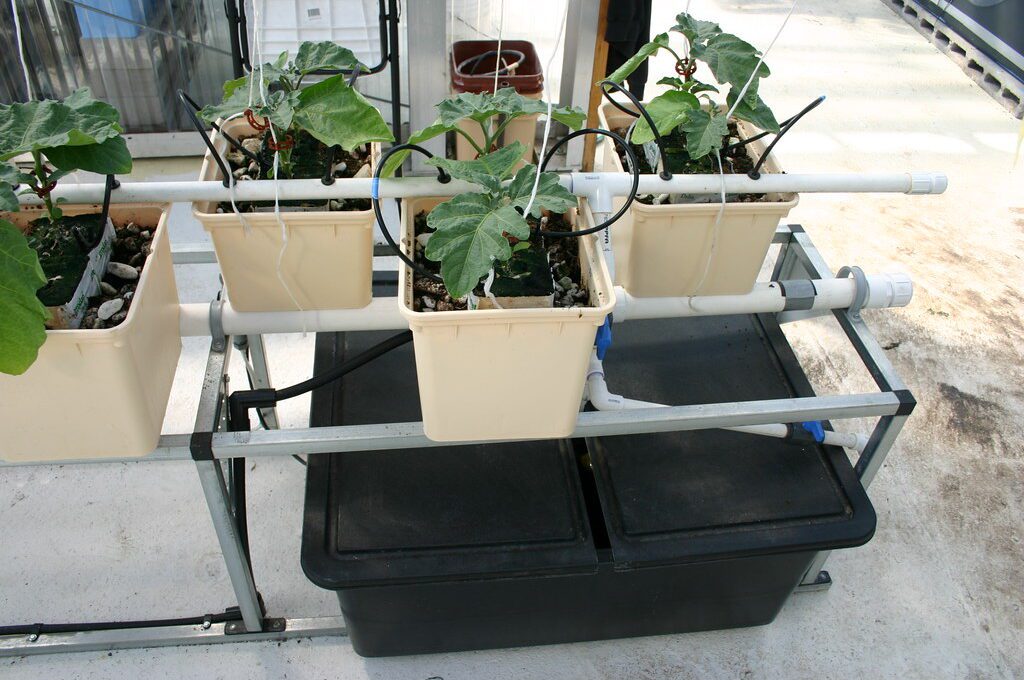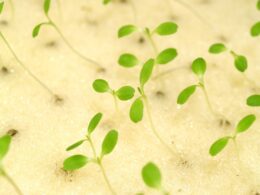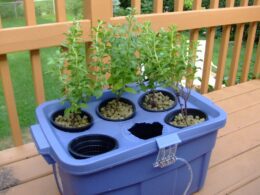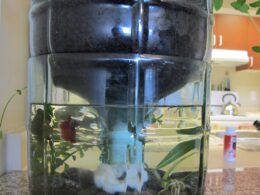Are you interested in hydroponics but don’t want to deal with the added responsibility of caring for fish? You’re in luck! It is possible to do hydroponics without fish and still achieve a successful and thriving garden.
Hydroponics is a method of growing plants without soil, using nutrient-rich water as a substitute. Aquaponics, on the other hand, combines hydroponics with aquaculture, using fish waste to fertilize the plants. While aquaponics can be a sustainable and efficient system, it requires more maintenance and attention than fish-free hydroponics.
In this article, we will explore the alternative nutrient sources available for hydroponics, the pros and cons of fish-free hydroponics, and provide tips for choosing the right system for you.
Overview of Hydroponics and Aquaponics
If you’re looking to explore alternative methods of growing plants, it’s worth considering both hydroponics and aquaponics, as they offer unique benefits and challenges.
Hydroponics is a growing method that doesn’t involve soil, but instead uses water and nutrient solutions to grow plants. This method is popular because it allows for greater control over growing conditions, such as temperature, light, and pH levels. In contrast, growing plants in soil can be unpredictable, and the quality of the soil can greatly affect plant growth.
One of the major differences in plant growth between hydroponics and soil is the rate at which plants grow. Hydroponic plants often grow faster than their soil-grown counterparts because they have access to a consistent supply of nutrients and water.
In a hydroponic system, plant roots are constantly submerged in nutrient-rich water, which allows them to absorb nutrients more efficiently. In contrast, soil-grown plants may experience drought or nutrient deficiencies if the soil isn’t regularly watered or fertilized.
Aquaponics is a similar method to hydroponics, but it involves the use of fish to provide nutrients to the plants. In this system, fish waste is broken down by bacteria and converted into nutrients that the plants can absorb.
While aquaponics can be a more sustainable method of growing plants, it also requires more attention to fish health and water quality.
Ultimately, whether you choose to use hydroponics or aquaponics, both methods offer unique benefits and challenges that can help you achieve your goals as a gardener or farmer.
Alternative Nutrient Sources
Consider exploring alternative nutrient sources for your hydroponic system, as there are many options available beyond using fish. One of these options is vertical gardening, which is a method of growing plants in a vertical space rather than on a horizontal plane. This is especially useful for urban farming, where space is limited.
Vertical gardening can be achieved through the use of hydroponics, where the plants are grown in a nutrient-rich solution without soil. This solution can be made from a variety of alternative nutrient sources, such as compost tea, worm castings, and seaweed extract. These sources provide essential nutrients for plant growth, without the need for fish or other animal-based products.
Another alternative nutrient source for hydroponics is synthetic fertilizers, which are made from chemical compounds. While they are effective in providing essential nutrients for plant growth, they can be harmful to the environment and can also negatively impact the taste and quality of the plants. Therefore, it’s important to use them sparingly and to choose organic and eco-friendly options when possible.
By exploring these alternative nutrient sources, you can create a sustainable and healthy hydroponic system without relying on fish.
Is it Possible to Have a Successful Hydroponic System Without Using Fish?
Is it possible to achieve indoor hydroponics efficiency without using fish? Many modern hydroponic systems utilize alternative methods such as nutrient solutions and artificial lighting to provide the necessary nutrients and growth conditions for plants. These systems allow for successful cultivation without the need for fish, providing a more sustainable and controlled environment for plant growth.
Pros and Cons of Fish-Free Hydroponics
Opting for fish-free hydroponics presents both advantages and disadvantages that you should carefully weigh before deciding on the nutrient source for your system.
On the one hand, using alternative nutrient sources eliminates the need for fish food and the associated costs and sustainability concerns. Additionally, fish-free hydroponics avoids the risk of diseases and parasites that can affect fish populations and harm the overall system.
On the other hand, fish provide essential nutrients that plants need to thrive, and it can be challenging to replicate these nutrients with alternative sources. Some hydroponic growers have reported lower yields and less robust plants when using fish-free systems. Moreover, the cost analysis of alternative nutrient sources can vary widely, depending on the supplier and the quality of the product. While some sources may be more affordable, others may be more expensive than traditional fish-based systems.
In summary, choosing between fish-based and fish-free hydroponics requires careful consideration of the pros and cons of each approach. While eliminating fish from the system can reduce costs and sustainability concerns, it can also impact plant growth and require more expensive nutrient sources. Ultimately, the decision depends on your specific needs and goals as a hydroponic grower.
Choosing the Right System for You
When choosing a hydroponic system, there are a few things to consider based on your specific needs. For example, how much space and time you have to devote to your system, and what types of plants you want to grow.
It’s also important to consult with experts in the field to ensure that you’re making the best decisions for your setup. By taking these considerations into account, you can create a successful and efficient hydroponic system that meets your needs.
Considerations for Your Specific Needs
If you’re interested in hydroponics but don’t want to incorporate fish into your setup, there are still plenty of options available to you.
The first thing to consider is whether you’d like an indoor or outdoor system. Indoor systems are great for year-round growing and can be easier to control since they’re not subject to weather changes. However, they tend to be more expensive since you’ll need artificial lighting and a controlled environment.
Outdoor systems are cheaper and can be more natural, but they’re also subject to the elements and may require more maintenance.
Cost is another important factor to consider. While hydroponics can be more expensive to set up initially, it can save you money in the long run since you won’t need to buy soil or pesticides. However, you’ll need to factor in ongoing costs such as electricity, nutrients, and maintenance.
Additionally, some systems may require more expensive equipment like pumps and timers.
Consider your budget and what you’re willing to spend before choosing a system.
Ultimately, the best system for you will depend on your specific needs and preferences.
Consulting with Experts
Consulting with experts is essential for getting the most out of your hydroponic setup and ensuring optimal plant growth and health. Even if you think you have a good grasp of the basics, there are always factors that may not have crossed your mind.
Experts can help you troubleshoot issues that may arise, and advise you on the best practices for your specific setup. They can also give you insight into the benefits of soil-based farming, and how to effectively compare the cost of hydroponics and traditional farming.
When it comes to hydroponics, the initial investment can be high, but over time, the benefits can outweigh the cost. Experts can help you understand the long-term savings and the potential income streams that hydroponics can provide.
By consulting with experts, you can make informed decisions that will benefit both you and your plants. So, don’t be afraid to reach out to those with experience and knowledge in the field of hydroponics.
Tips for Success
To ensure success in your hydroponic setup, follow these helpful tips. First, choose the right hydroponic media. Hydroponic media is what your plants will grow in and it plays a significant role in the success of your hydroponic garden. Common options include rockwool, expanded clay pellets, and coconut coir.
Second, choose the right lighting options. Lighting is important because it helps your plants grow faster and healthier. LED lights are a popular option as they’re energy-efficient and emit less heat than other lighting options.
Third, maintain your hydroponic setup regularly. This includes checking the pH level of your water, monitoring the nutrient levels, and regularly cleaning your system. Maintaining your setup will ensure that your plants are getting the right nutrients and growing in a clean environment.
Additionally, be sure to keep an eye on your plants for any signs of pests or diseases. Catching these early can prevent them from spreading and affecting your entire hydroponic setup. By following these tips, you can successfully grow plants in a hydroponic setup without fish.
Remember, hydroponics can be a fun and rewarding hobby, but it requires consistent effort and attention to detail. With the right media, lighting, and maintenance, you can enjoy a thriving hydroponic garden.
Frequently Asked Questions
How much space do I need to set up a fish-free hydroponics system?
To set up a fish-free hydroponics system, you’ll need to consider the space you have available. Vertical gardening is a great option for maximizing your space and growing plants indoors. You can use shelves or hanging baskets to create a vertical garden that doesn’t take up much floor space.
Indoor farming also allows you to control the environment, including the temperature, humidity, and lighting. With a fish-free hydroponics system, you can grow plants using a nutrient-rich solution instead of soil. This method of growing is efficient and allows you to grow more plants in a smaller area.
With the right setup, you can enjoy fresh produce year-round, even if you don’t have a lot of space.
What are some common mistakes to avoid when starting a fish-free hydroponics system?
Starting a fish-free hydroponics system can be a great way to grow fresh produce without the hassle of dealing with fish. However, there are some common mistakes that you should avoid to ensure that your system runs smoothly.
One of the biggest mistakes is not giving your plants enough light. Make sure that your plants are getting enough light by placing them in a spot that receives plenty of direct sunlight or by using grow lights.
Another common mistake is not properly balancing the pH levels in your system. Troubleshooting tips for this issue include monitoring the pH levels regularly and adding pH adjusters as needed.
Overall, with some careful planning and attention to detail, you can create a successful fish-free hydroponics system that will provide you with fresh, healthy produce year-round.
Can I use tap water for my fish-free hydroponics system?
Using tap water for your fish-free hydroponics system can be a good option, but it’s important to consider the quality of your tap water. Tap water can contain chlorine, which can harm your plants. To avoid this, it’s best to let the tap water sit for at least 24 hours before using it in your system.
You can also consider using an alternative nutrient source, such as liquid or powdered nutrients, to ensure your plants are getting the necessary nutrients they need to thrive. It’s important to do your research and choose a nutrient source that works for your specific plants and system.
By paying attention to tap water quality and choosing the right nutrient source, you can successfully grow plants in your hydroponics system without the need for fish.
What types of plants grow best in a fish-free hydroponics system?
Looking for plants that thrive in a fish-free hydroponics system? You’ll be happy to know that there are plenty of options.
Some of the top performing plants include leafy greens like spinach, lettuce, and kale, as well as herbs like basil, mint, and cilantro.
When it comes to nutrient solutions, there are a variety of options available that don’t rely on fish waste. You could use a pre-made nutrient mix, or even make your own using ingredients like worm castings, compost tea, or seaweed extract.
With the right setup and care, you can enjoy a bountiful harvest of healthy, delicious plants without the need for fish in your hydroponics system.
How long does it take to see results in a fish-free hydroponics system compared to a traditional hydroponics system?
Compared to aquaponics, a fish-free hydroponics system can yield results much faster. You may start seeing results within a week or two of starting your system. The benefits of fish-free systems are many – they’re less complex to set up and maintain, and you don’t have to worry about the health and well-being of your fish.
Additionally, fish-free systems allow for greater flexibility in the types of plants you can grow, since you don’t have to worry about the compatibility of certain plants with fish. Overall, a fish-free hydroponics system is a great option for anyone looking for a simple, efficient, and effective way to grow plants.
Conclusion
So, can you do hydroponics without fish? The answer is yes!
While aquaponics is a popular method that combines hydroponics with fish farming, there are alternative nutrient sources available that allow for fish-free hydroponics. Using nutrient solutions or compost teas can provide the necessary nutrients for plant growth.
There are pros and cons to fish-free hydroponics, such as avoiding the upkeep and expense of fish, but also potentially missing out on the benefits they can provide. Ultimately, the choice between fish-based or fish-free hydroponics depends on personal preference and the specific goals of the grower.
Whatever system you choose, following these tips for success such as maintaining proper pH levels, monitoring nutrient levels, and choosing the right plants for your system will lead to a successful hydroponic garden.









